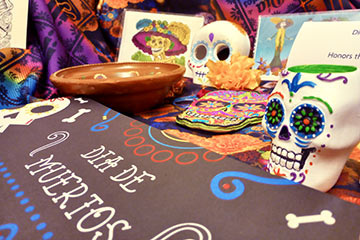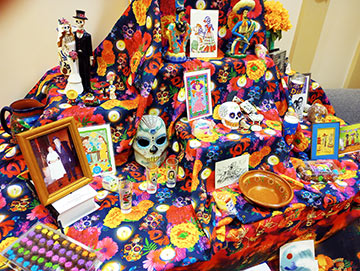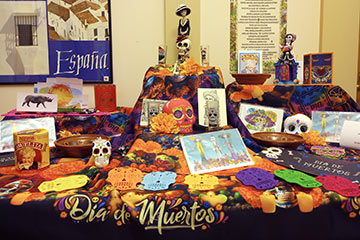
10/24/2023
The terrifying ghosts, zombies, vampires and other once-dead creatures of Halloween dominate American culture each year on Oct. 31.
But SUNY Cortland’s Modern Languages Department wants you to know there’s another — happier — way to remember the dearly departed.
Next week, anyone on campus can embrace a lighter side to the Other Side as part of the department’s Day of the Dead celebration.
Lecturer Patricia Martinez de la Vega Mansilla restarted a tradition at SUNY Cortland last year of creating traditional altars, or ofrendas, for the holiday after it had been interrupted by the COVID pandemic.

“We want the students to get a better understanding of the celebration that we have and realize that, while of course death is something that makes us sad, it’s also a celebration of the cycle of life and an opportunity to honor our departed,” she said. “It’s a way of never forgetting them.”
The Day of the Dead, or Dia de los Muertos, is an annual tradition on Nov. 1 and 2 that began in Mexico and acts as a joyful family reunion for the living and deceased alike. Parades and parties give a chance to overcome the grief of death by letting participants have some laughter about the hereafter and revel in the inevitable.
As part of the holiday, families decorate cemeteries and build ofrendas at home that help spirits find their way. These ofrendas traditionally include photos, candles, flowers, food and decorations. Marigolds' orange and yellow petals represent the sun and light, while Sugar skulls add a candy kicker to the festivities.
After last year’s successful restart, Martinez de la Vega Mansilla and Dana Smith, the Modern Languages Department's administrative assistant, decided to expand the project to three ofrendas instead of one. They all include traditional Dia de los Muertos symbols of water, fire, earth and wind. Portions of them will, for the second time, also have images of extinct animal species and their habitats to raise ecological awareness.

Students, staff and faculty are all invited to view them throughout the week of Oct. 29. The three altars can be found in Old Main in the Modern Languages Department’s main office, Room 227 and Room 225.
Martinez de la Vega Mansilla said that the ofrendas help students with their Spanish language proficiency, and that the project also adds to their cultural education and understanding.
“Languages are not just the reading, writing, speaking and listening abilities,” she said. “It’s understanding the culture behind every language. So as part of our cultural understanding of Spanish, and specifically Mexico, we celebrate the Day of the Dead.”
The enthusiasm from campus — both for the ofrendas and the chance to join in Dia de los Muertos — has been wonderful to see, Martinez de la Vega Mansilla said.
“I have an international student who is Mexican, and she was thrilled to see it. We also invite people to bring pictures of their loved ones. I placed my parents’ picture with Don Quixote de la Mancha, the book that was my dad’s favorite, and that my mom and I have a history with, too. And other faculty members and students are putting pictures to honor their relatives.”